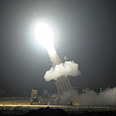
World shows interest in Iron Dome, but some skeptical
New York Times reports antimissile experts have expressed doubts over rocket interception system's efficiency, saying 'bright flashes can create a visual impression of overwhelming interceptor success, when in fact they may represent the interceptor warhead blowing up'
VIDEO - The successful performance of the Iron Dome rocket interception system during Operation Pillar of Defense in the Gaza Strip has created new interest in the global arms market.
Countries like South Korea and Singapore have already expressed an interest in the system, and some military defense officials in the United States have called on the US Army to consider buying the Iron Dome system to support ground units such as those deployed in Afghanistan.
Reporter: Sivan Raviv (Video courtesy of jn1.tv)
But according to a Friday report in the New York Times, some doubt the system's efficiency. American technical experts say they want hard evidence before judging whether Iron Dome knocked out as many rockets as Israel claimed at the end of the operation.
Related stories:
- Iron Dome believers enlist in IDF Iron Dome shootdowns cost $25-30M Op-ed: Time to thank Amir Peretz
According to Israel, during the conflict with Hamas the Iron Dome system intercepted more than 400 rockets fired from the Gaza Strip at populated centers, with an 85% success rate. Hamas, on the other hand, claimed that it had launched more than 1,400 rockets into Israel throughout the eight-day operation.
American antimissile experts expressed their doubts over the system, which was built with American financial support totaling $275 million. According to these skeptics, bright flashes can create a visual impression of overwhelming interceptor success, when in fact they may represent nothing more than the interceptor warhead blowing up.
“I’ve met the guys in Israel, and they’re smart,” Richard M. Lloyd, an antimissile expert, told the New York Times. “But I’m not seeing the things I want to see” to prove that Iron Dome actually succeeded to the extent described by Israel.
Lloyd said he had studied dozens of publicly available photographs of spent rockets that landed on Israel. Few of them, he said, showed signs of damage from Iron Dome’s exploding warhead and the specific mechanism by which the interceptor is designed to make its kill — a dense spray of speeding metal fragments.
He acknowledged, however, that some of the photographs may have been of enemy rockets that Iron Dome had not targeted because they were not headed toward populated areas. “I’m not saying the system is no good,” he stressed. “I’m saying I need more information.”
Another antimissile expert noted that the Israelis might have been tempted to exaggerate the degree of antimissile success as a calculated maneuver. According to the New York Times, Israeli officials reject such skepticism and stand by the statistics of Iron Dome’s success that they have released.
“The numbers are very accurate,” said one Israeli official with knowledge of the system. “Many of these video clips and pictures were taken by citizens, not professionals. You cannot learn very much from videos taken with an iPhone.”
- Follow Ynetnews on Facebook and Twitter
- Receive Ynetnews updates directly to your desktop










